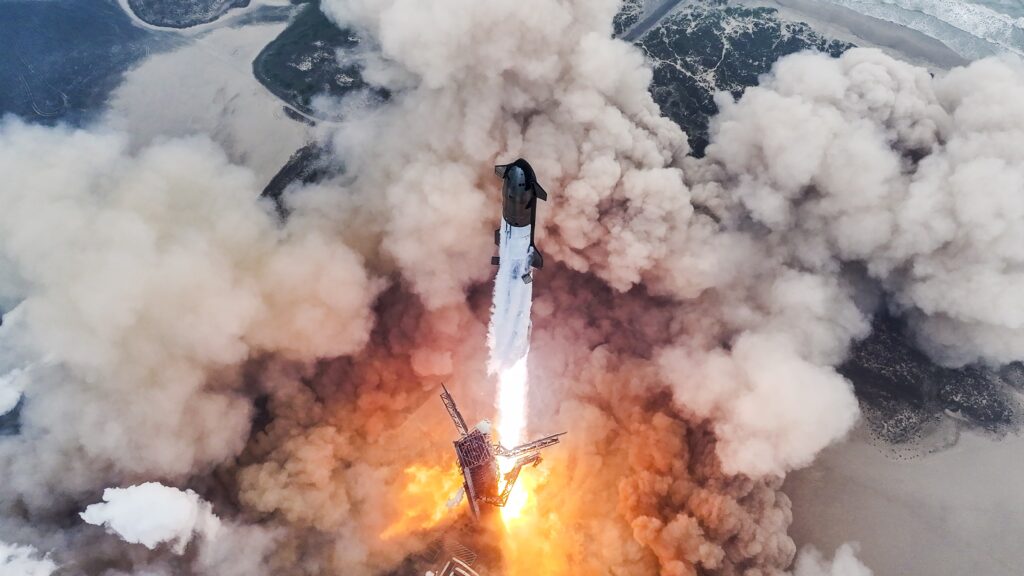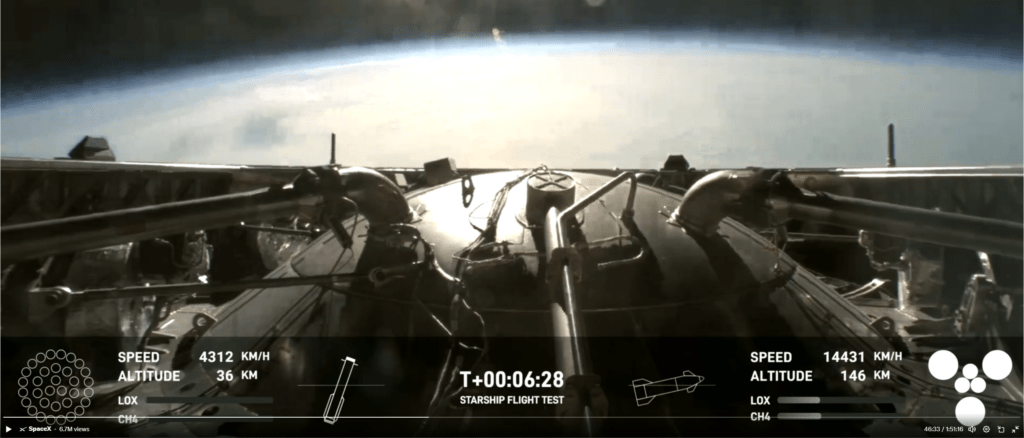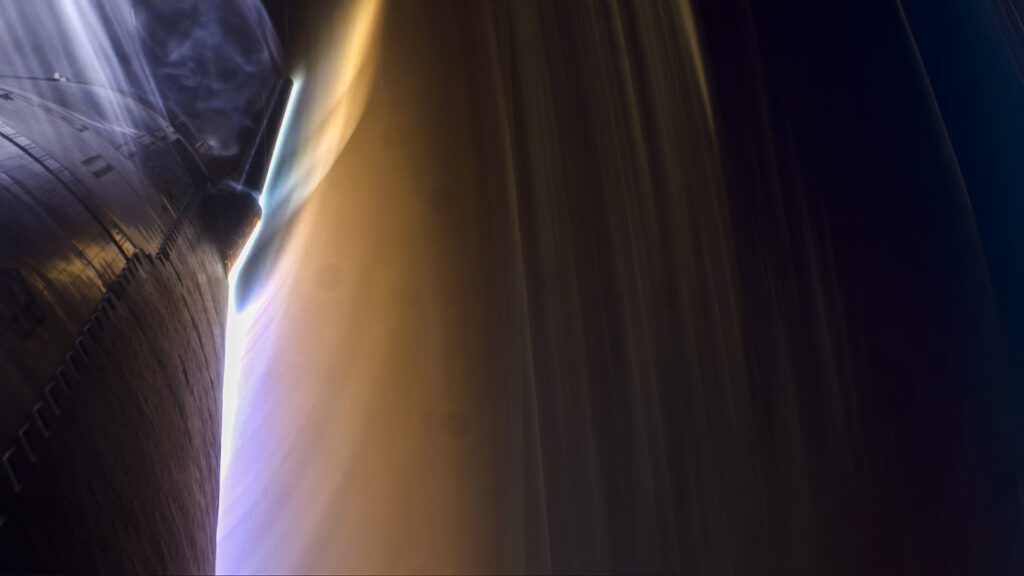Today marked a historic day in space exploration with SpaceX’s Starship completing its fourth flight test, Boeing’s Starliner docking with the ISS, and China’s Chang’e-6 mission succeeding in retrieving lunar samples from the dark side of the Moon.
Starship IFT-4
The Starship took off for the fourth time from Starbase in Boca Chica. This time around there were no major issues like the first time when a bunch of Raptor engines were damaged by the launch pad debris. One of the rocket engines was not functional, but this did not impact the mission’s success in any way. And so the largest rocket in mankind’s history roared into the sky. I was amazed by the rocket’s shockwaves, which could be spotted via the rocket’s live cameras.

Around T+2:52, it was time for booster separation. Here, SpaceX performed what is called a hot staging maneuver. Hot staging means that the rocket ignites its engines immediately during separation instead of waiting for the two stages to separate first. On one hand, this adds additional requirements to the structure of the rocket—it needs to be able to withstand the direct force of the upper-stage rocket engines. However, by doing this, they save some time, which gives them more delta-V. The separation too was without any problems.

After a successful separation, the booster turned around and relit its engine to boost back towards Boca Chica. Its target was to land in the sea, not far off from the beach where it launched. The goal was to demonstrate its ability to return to the launch pad in future test flights. Meanwhile, the upper stage continued on its suborbital trajectory to reach the other side of the Earth and land in the Indian Ocean. This time around, the booster also separated from the hot stage—the booster’s upper part that protects it from the upper stage engines. This is a temporary fix that will be revised in future iterations of the rocket.

And so the flight excitedly continued with the booster returning towards Earth. Throughout the entire flight, everything was live-streamed to the audience with the help of SpaceX’s Starlink constellation. This certainly proved the system’s reliability – there was almost no lag, even though the signal was being transmitted from a rocket in space. And so not long after around T+7:30, the booster completed a soft landing in the sea for the first time. It was tense all along. The booster was still returning at the speed of over 1000 km/h, then the engines lit and the rocket slowed down to a successful splashdown.

It was very unfortunate that I had an exam just when Starship was about to take off, but I managed to get back just in time to see the finale. The upper stage coasted along its trajectory until it reached its destination—the airspace above the Indian Ocean. It was time for the ultimate test. Would the Starship make it all the way to the sea without exploding? Would it be possible to do a soft landing with a belly-flop maneuver? We were about to find out! The plasma around the ship began showing around T+44:40 when the Starship approached the Karman line—the border between space and atmosphere. At this height, there is almost no air. However, due to the ship’s insane speed—over 26,000 km/h, which is near orbital speed—the air starts compressing and this creates plasma. So, it was a question of whether the ship would be able to withstand the heat of the plasma and the force of reentry. The reentry was really smooth at first and at times it was so stable I thought the stream froze. We got many different views from different parts of the rocket, which was a real eye candy.

Everything was live-streamed! Even though the spacecraft was entering the atmosphere at near orbital speeds and was surrounded by hot plasma which blocked all the signals, it was able to transmit video via the Starlink network. And how might that be possible? It is due to Starship’s size. It is so big that it creates a zone behind it that is not affected by the plasma, and this in combination with Starlink allows it to transmit signals even during the descent. We truly got some amazing views and at around T+56:30, it was clear that something wasn’t going entirely according to plan. One of the Starship’s flaps was starting to melt. Melt from the heat of the plasma.

And what caused this? Most likely the gap between the flap and the rest of the ship. So this is something that will have to be worked on in future iterations of Starship. At this point, I thought it was over. I thought the ship was going to reach the sea and explode. A quarter of its flap was pretty much gone and melted away. And yet, Starship did not give up just yet. We lost connection a couple of times, thought it was over, then regained connection, etc. My heartbeat was going crazy and I was expecting the worst. But somehow the ship was still sending data and we were still able to see the image all the way to the end—even though the camera was covered by molten steel, which unfortunately didn’t give the best views. Alas, after 10 excruciating minutes, it was time for the final maneuver—the belly flop. And to my surprise, it succeeded even at that. The heroic flap was still working—it still moved even though it was half melted away. At T+01:05:40, the ship successfully completed the belly-flop maneuver and landed in the Indian Ocean. I shed a tear of happiness and was looking forward to more footage of this unforgettable launch! What an amazing flight!
Starliner’s Successful Docking
Today, Boeing’s Starliner also docked with the ISS. Starliner is a crew capsule capable of bringing astronauts to space. It competes with SpaceX’s Dragon capsule. I shortly read about it and for the most part, the docking was a success. However, there seemed to have been two big problems: a helium leak and a temporary loss of thrusters during its journey to the space station. The astronauts were then given a warm welcome aboard the ISS and celebrated the mission’s success.
China’s Chang’e 6 Mission
And there was yet another milestone achieved on this day. Chinese lunar mission Chang’e 6’s lander successfully docked with the orbiter after retrieving lunar samples from the dark side of the Moon. This makes China the first country to retrieve a lunar sample from the dark side of the Moon. Once again, we were treated to some amazing footage. Now we wait for the samples to return to Earth. Hopefully, the samples will provide valuable insight into the composition and history of the Moon’s far side, potentially unlocking new information about the formation and evolution of our natural satellite.
This remarkable day in space exploration fills me with hope for the future. With upcoming missions like another Starship flight, Starliner’s return, and more ISS activities, the next chapters in spaceflight promise even more excitement and discovery.
![The Past, Present and Future of Mars [Part 0]](https://davidblog.si/wp-content/uploads/2021/08/Mars-Website-banner-1-1024x576.jpg)